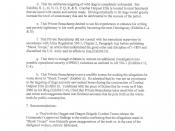�
Executive Misconduct
In the last decade, executive misconduct of varying types, as unfortunate as it may be, have become regular front-page news headlines or a top television news story. This paper will define some of the categories of misconduct and discuss personal and business ethics around executive misconduct. In addition, it will look at why top executives feel they are "above the law" or above the standards imposed on others. Whether these executives should be held as such, and how the companies they work for are affected. Ultimately, it will address the challenge of disciplining top executives.
Executive misconduct by definition occurs when a company official is involved or associated with a "wrongful, improper or unlawful conduct motivated by premeditated or intentional purpose or by obstinate indifference to the consequences of one's acts" ("Misconduct," 2007). We have also heard executive misconduct referred to as white-collar crime. Edwin Sutherland defines white-collar crime "as a crime committed by a person of respectability and high social status in the course of his occupation" ("White-collar crime," 2007).
Although there has been some debate as to what qualifies as white-collar crime, "the term today generally encompasses a variety of nonviolent crimes usually committed in commercial situations for financial gain" (Cornell University Law School, 2007). White-collar crime can therefore overlap into the corporate crime world because the opportunity for fraud, computer crime, embezzlement, etc. is more available to white-collar employees. With that being said, categories of misconduct can be summarized into three major categories; financial impropriety, harassment, and personal conduct that proves embarrassing to a corporation; all of which can be legal or illegal.
Financial impropriety, or known in the slang term as "cooking the books" is defined as
"fraudulent activities performed by individuals within a corporation in order...


